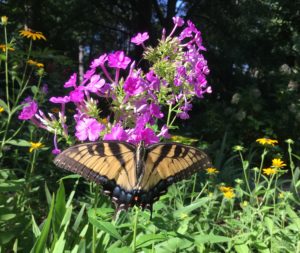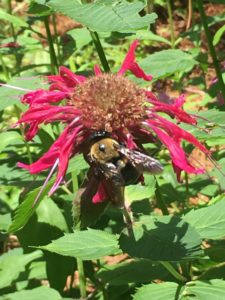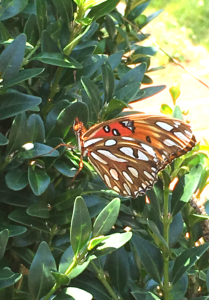
My garden is very busy these days, as birds, butterflies and bees seek the last bit of nectar and pollen before the weather changes. The flowers seem to take flight themselves as these winged wonders flit from one blossom to the next in a frantic effort to prolong the season.

But of course these birds and insects do much more than add beauty to the garden. It’s difficult to overemphasize the importance of our native pollinators. It’s estimated that the reproduction of 90% of flowering plants and one third of human food crops depend on pollination by insects and other animals. Pollinators not only provide an essential element in the food chain, they also help maintain healthy and thriving ecosystems wherever they are found.
Butterflies are delicate feeders, usually perching on top of a blossom. As they look for nectar, they collect pollen on their legs. Bees, on the other hand, get down and dirty, burrowing down into the blossom and getting covered with pollen (think of the Peanuts character Pig-Pen), which they then take to the next flower.

The South has a wonderful diversity of natural pollinators. According to the Xerces Society (an outstanding educational and advocacy organization in Portland, Oregon), the South is home to 18 different species of bumble bees, and thousands of native bees, butterflies, beetles, wasps, and moths.
Native pollinators, in many cases, have co-evolved with the native plants and are ideally and sometimes tragically dependent on one another. Take, for example, the Monarch butterfly, whose larva feeds ONLY on the leaves of the milkweed plant. With reduced numbers of milkweed populations, the monarchs have suffered as well.

Unfortunately, native pollinator populations have decreased in the last decade. But, you can help. The Xerces Society is sponsoring a “Bring Back the Pollinators” campaign and hopes to get one million people to sign a pledge to 1. grow more flowers 2. protect bee nests and butterfly host plants 3. avoid pesticides and 4. spread the word. To sign this pledge, go to https://xerces.org/

I have two grandchildren who are allergic to bee stings so I’m super cautious about flying, stinging insects in the garden. But, I’m also very aware of the importance of explaining to them (and their parents) the necessity of learning to co-exist with the all creatures in our gardens. Without them, we would have no gardens. Even though our first instinct might be to destroy bees and their nests, we need to remember that bees provide an irreplaceable link in the pollinator sequence. So, take whatever cautions are necessary to keep susceptible children (and adults) safe but also remember that humans are only one link in the complicated web of life.
P.S. I have several coloring book pages of wildflowers and their animal partners. If you would like some, just email me and I’ll send them to you!

Thank you for this! Come see our new garden at Westminster’s Love Hall; it is beautiful! Maybe you would like to do a talk one day? We also have started composting — just apples and bananas. The first grade is very involved in this work, so if you are a compost fan, let me know!
Love seeing your drawings in your posts! Keep ’em coming.